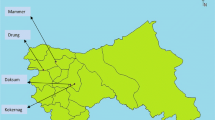Abstract
Worldwide genus Amanita is represented by more than 500 ectomycorrhizal (ECM) species. These species form mutualistic associations with a number of host trees among which the conifers predominate. Set out to explore the ECM associations of Amanita in Kashmir Himalayas, Amanita calyptroderma, Amanita pantherina and Amanita vaginata show symbiotic associations with the roots of Pinus wallichiana. Besides morphological characterization of mycorrhizal roots and sporocarps, molecular characterization of rDNA ITS region was performed for identification of species. ITS-rDNA was used for molecular analysis. The target region of rDNA was amplified using universal fungal primers (ITS1 and ITS4). The sequencing of amplified products and their subsequent blast analysis confirmed the identification of species by comparing the sequences of these species with sequences present in GenBank. Phylogenetic analysis also confirmed the identification of species.




Similar content being viewed by others
References
Smith SE, Read DJ (2008) Mycorrhizal Symbiosis, 3rd edn. Academic Press, London
Itoo ZA, Reshi ZA (2013) The multifunctional role of ectomycorrhizal associations in forest ecosystem processes. Bot Rev. doi:10.1007/s12229-013-9126-7
Rinaldi AC, Comandini O, Kuper TW (2008) Ectomycorrhizal fungal diversity separating wheat from the chaff. Fungal Divers 33:1–45
Zhang L, Yang J, Yang Z (2004) Molecular phylogeny of eastern Asian species of Amanita (Agaricales, Basidiomycota): taxonomic and biogeographic implications. Fungal Divers 17:219–238
Pande V, Palni UT, Singh SP (2004) Species diversity of ectomycorrhizal fungi associated with temperate forest of Western Himalaya: a preliminary assessment. Curr Sci 86:1619–1623
Watling R, Abraham SP (1992) Ectomycorrhizal fungi of Kashmir forests. Mycorrhiza 2:81–87
Ingleby K, Mason PA, Last FT, Fleming LV (1990) Identification of ectomycorrhizas. Institute for Terrestrial Ecology, Natural Environmental Research Council, London
Agerer R (1994) Index of unidentified ectomycorrhizae III. Names and identifications published in 1992. Mycorrhiza 4:183–184
Sette LD, Passarin MRZ, Delarmelina C, Salati F, Duarte MCT (2006) Molecular characterization and antimicrobial activity of endophytic fungi from coffee plants. World J Microbiol Biotechnol 22:1185–1195
Peintner U, Moser MM, Thomas KA, Manimohan P (2003) First records of ectomycorrhizal Cortinarius species (Agaricales, Basidiomycetes) from tropical India and their phylogenetic position based on rDNA ITS sequences. Mycol Res 107:485–494
Manassila M, Nguan TS, Boonkerd N, Rodtongb S, Teaumroonga N (2005) Phylogenetic diversity of wild edible Russula from Northeastern Thailand on the basis of internal transcribed spacer sequence. Sci Asia 31:323–328
Itoo ZA, Reshi ZA, Andrabi KI (2013) Characterization and identification of Russula firmula and Russula postiana from Himalayan moist temperate forests of Kashmir. Afr J Biotechnol 12:3643–3647
Atri NS, Kaur A, Kaur H (2003) Wild mushrooms—collection and identification. Chambaghat, Solan
Higgins DG, Bleasby AJ, Fuchs R (1992) CLUSTAL V: improved software for multiple sequence alignment. Comput Appl Biosci 8:189–191
Tamura K, Peterson D, Peterson N, Stecher G, Nei M, Kumar S (2011) MEGA5: molecular evolutionary genetics analysis using maximum likelihood, evolutionary distance and maximum parsimony methods. Mol Biol Evol 28:2731–2739
Felsenstein J (1995) PHYLIP—phylogenetic inference package, version 3.5c. Computer programs distributed by the author. Department of Genetics, University of Washington, Seattle
Felsenstein J (1985) Confidence intervals on phylogenies: an approach using the bootstrap. Evolution 39:783–791
Avin FA, Bhassu S, Shin TY, Sabaratnam V (2012) Molecular classification and phylogenetic relationships of selected edible Basidiomycetes species. Mol Biol Rep 39:7355–7364
Siddiquee S, Tan SG, Yusuf UK, Fatihah NH, Hasan MM (2012) Characterization of Malaysian Trichoderma isolates using random amplified microsatellites (RAMS). Mol Biol Rep 39:715–722
Gonzalez P, Labare`re J (2000) Phylogenetic relationships of Pleurotus species according to the sequence and secondary structure of the mitochondrial small-subunit rRNA V4, V6 and V9 domains. Microbiology 146:209–221
Ito Y, Fushimi T, Yanagi SO (1998) Discrimination of species and strains of basidiomycete genus Coprinus by random amplified polymorphic DNA (RAPD) analysis. Mycoscience 39:361–365
Shnyreva A, Shtaer O (2006) Differentiation of closely related oyster fungi Pleurotus pulmonarius and P. ostreatus by mating and molecular markers. Russ J Genet 42:539–545
Choi DB, Ding JL, Cha WS (2007) Homology search of genus Pleurotus using an internal transcribed spacer region. Korean J Chem Eng 24:408–412
Nilsson RH, Kristiansson E, Ryberg M, Hallenberg N, Larsson KH (2008) Intraspecific ITS variability in the kingdom Fungi as expressed in the international sequence databases and its implications for molecular species identification. Evol Bioinform 4:193–201
White T, Bruns T, Lee S, Taylor J (1990) Amplification and direct sequencing of fungal ribosomal RNA genes for phylogenetics. PCR protocols a guide to methods and applications. Academic Press, San Diego, pp 315–322
Kulmann C, Kim SJ, Lee SS, Harms C (2003) A reliable, “Direct from Field” PCR method for identification of mycorrhizal fungi from associated roots. Mycobiology 31:196–199
Reddy MS, Singla S, Natarajan K, Senthilarasu G (2005) Pisolithus indicus, a new species of ectomycorrhizal fungus associated with Dipetrocarps in India. Mycologia 97:838–843
Itoo ZA, Reshi ZA (2013) Effect of different nitrogen and carbon sources and concentrations on the mycelial growth of ectomycorrhizal fungi under in vitro conditions. Scand J For Res. 10.1080/02827581.2014.964756
Itoo ZA, Basharat Q, Majeed ST, Andrabi KI, Reshi ZA (2014) Ectomycorrhizal fungal species of Kashmir Himalaya: identification and characterization by ITS analysis. Braz J Bot. 10.1007/s40415-014-0081-2
Hortal S, Pera J, Galipienso L, Parlad´e J (2006) Molecular identification of the edible ectomycorrhizal fungus Lactarius deliciosus in the symbiotic and extraradical mycelium stages. J Biotechnol 126:123–134
Iotti M, Zambonelli A (2006) A quick and precise technique for identifying ectomycorrhizas by PCR. Mycol Res 110:60–65
Acknowledgments
The authors greatly appreciate Senior and Junior research fellowships in favour of Sheikh Tahir Majeed (09/251/0055/2013/EMRI) and Qussin Basharat (09/251/0045/2011/EMRI) from Council of Scientific and Industrial Research (CSIR) respectively. Special thanks to Sheetal Ambardar (School of Biotechnology University of Jammu) for her help in developing the phylogenetic analysis and providing valuable comments. The authors entitled to the authorship do not have any conflict of interest.
Author information
Authors and Affiliations
Corresponding author
Rights and permissions
About this article
Cite this article
Itoo, Z.A., Reshi, Z.A., Majeed, S.T. et al. Morphological and Molecular Characterization of Ectomycorrhizal Amanita Species Associated with Pinus wallichiana A. B. Jacks.. Proc. Natl. Acad. Sci., India, Sect. B Biol. Sci. 86, 985–994 (2016). https://doi.org/10.1007/s40011-015-0527-8
Received:
Revised:
Accepted:
Published:
Issue Date:
DOI: https://doi.org/10.1007/s40011-015-0527-8




